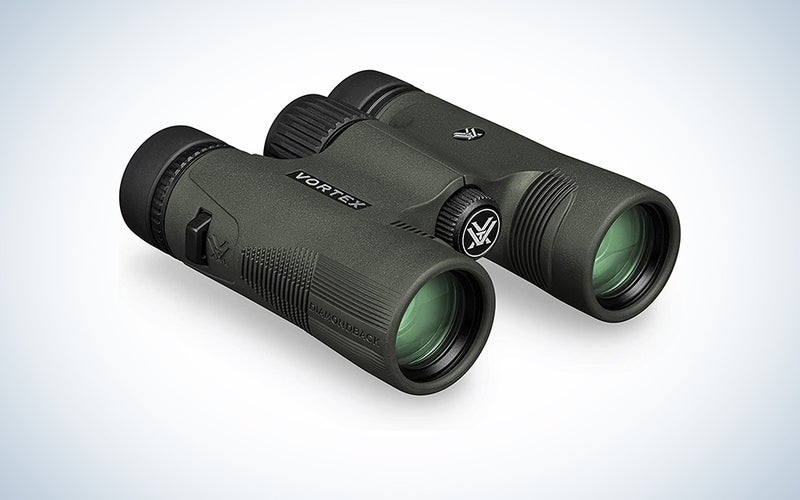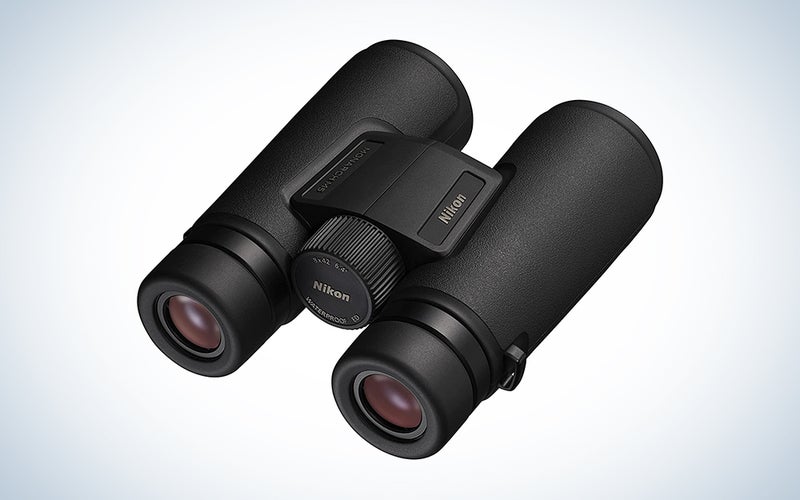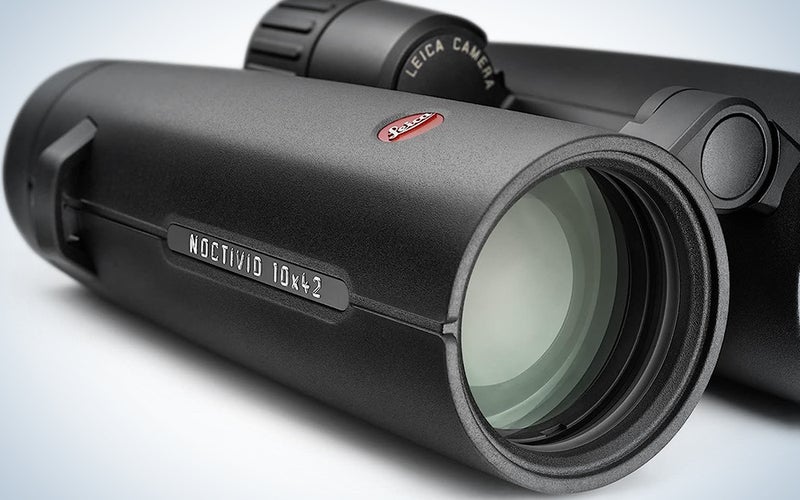We may earn revenue from the products available on this page and participate in affiliate programs. Learn more ›
Published Jun 23, 2023 5:00 PM
A great pair of binoculars can really heighten the experience of going on a nice hike. Whether you’re trying to look at birds or peaks in the distance, having binoculars to examine far-off features closely can make your hike easier and make it more enjoyable, allowing you to put fewer miles on your boots and still take in all the surrounding details. While some of the best optics are large and heavy, when considering binoculars for hiking, you will want something that is both easy to use and carry. Be careful not to go too far, though, as cheap toy binoculars will sacrifice the quality of your optics or the power of your magnification. Get something you can use, and that works in your pack of choice. To help you get the most out of your experience, we have compiled the best binoculars for hiking based on various needs, restrictions, and choices you’ll have to make to get the most out of your purchase.
Best overall: Vortex Optics Diamondback
Best value: Nikon Monarch
Best lightweight: Zeiss Terra ED
Best premium: Leica Noctivid
Best budget: Nikon Action EX
How we chose the best binoculars for hiking
To find the best binoculars for hiking, we scoured the internet for reviews and roundups from trusted sources, users, and reviewers. We looked at scores of binoculars, and compared reviews and rankings with a particular interest in the metrics we know our readers will care about, including weight, power, manufacturing quality, and ease of use. This attention to detail helps us find the best binoculars to recommend, no matter your needs and concerns.
The best binoculars for hiking: Reviews & Recommendations
After scouring the internet’s worth of options, we found the best binoculars for every use case. So, once you identify what metrics, price points, and features are important to you, you can find an appropriate recommendation below.
Best overall: Vortex Optics Diamondback

Why it made the cut: Great performance, easy to adjust, and affordable.
Specs
Weight: 13.5 oz
Magnification: 10x
Object Lens: 28 mm
Pros
Tripod mountable
Relatively lightweight construction
Independent eye adjust works well for users with glasses
Cons
Not great in low light
These binoculars won our best overall for their durable construction, above-price performance, lightweight, and long feature list. The Diamondback is great for backpacking thanks in part to its weight, coming in at less than 14 ounces, and its durable construction, including external rubber armor and waterproof, fogproof, and dust-resistant construction with hefty o-ring seals. The lenses are also scratch-resistant and have an anti-reflective coating. In addition, they come with a lifetime warranty.
The binoculars are easy to adjust thanks to a central adjustment wheel, but a diopter makes them easy to adjust for the vision of each eye. Glasses wearers will also appreciate that the eyepieces twist out for fine adjustment. While the 10x magnification is great, especially in such a small package, and the image is clear, these binoculars do struggle in low light, so they aren’t the best option for those looking to use them at dawn and dusk.
Best value: Nikon Monarch

Why it made the cut: Great image and color for the price if you’re willing to spend more than bottom dollar.
Specs
Weight: 1 lb 6.4 oz
Magnification: 8x
Object Lens: 42 mm
Pros
Bright image and colors
Clear image to the edges
Cons
Could be more compact
Narrower field of vision
The Nikon Monarch offers impressive image color and brightness at a price point for those looking to move beyond the most entry-level options. For these reasons, they’re a great value pick.
While the field of vision is a bit narrow compared to some of the other binoculars on this list, the binocular image stays clear, bright, and crisp all the way to the edges. Lens coatings help the consistency of color and clarity. The body is rubberized, which adds to its durability and ability to take an impact. To keep them going strong year after year, Nikon also made the binoculars waterproof and fogproof. These binoculars are also easy to use, with rubber eyecups for comfortable viewing and a slide wheel to help with the focus. While there are a few areas for improvement, like the narrow field of vision, getting a brighter and crisper image in a pair of binoculars without spending far more money is hard.
Best lightweight: Zeiss Terra ED

Why it made the cut: They are so portable even ultralight backpackers might consider taking them on a thru-hike.
Specs
Weight: 10.9 oz
Magnification: 8x
Object Lens: 25 mm
Pros
Comfortable design
Durable and light construction for the elements
Sharp and precise images
Cons
You pay for that lite weight
If you’re looking for a lightweight binocular option with heavyweight performance, shelling out the money for the Zeiss Terra ED is a worthwhile investment. These binoculars weigh less than three-fourths of a pound, measure just over 4 inches, and fold into a small, portable package that fits in a pocket. Despite this, when you unfold the Terra ED, it still fits well in your hand and is easy to adjust with a central focus wheel positioned near your index finger.
The clarity and brightness would be impressive at any size, especially at dawn, dusk, and low-light situations. The lenses also have a hydrophobic and anti-reflective coating to keep images clear and allow you to use the binoculars successfully during any weather. While the price is not lightweight, the performance and size make this a worthwhile purchase for those trying to shave ounces and have easy pocket access.
Best premium: Leica Noctivid

Why they made the cut: You get what you pay for, and you get a whole lot with these premium binoculars.
Specs
Weight: 1 lb 14.3 oz
Magnification: 10x
Object Lens: 42 mm
Pros
Elite clarity and brightness
Premium construction quality
Cons
A lot of money
Not as comfortable as the price tag would suggest.
If you are looking for the best of the best, get out your checkbook and grab these Leica binoculars. What you will first notice with the Noctivid is the crystal clear image extending to the edges of your field of view, thanks to those famously luxe Leica lenses. There is little to no distortion, which will help you spot a bird or landmark as they just barely graze past the field of view. And that is a lot of area, as these have a wide and satisfying field of view.
The lenses are also great in all conditions thanks to an Aquadura hydrophobic coating that keeps water off them, so you don’t have to wipe them in the rain constantly. If you want to wipe them, the coating also makes cleaning supremely easy. These lenses also offer an almost unparalleled brightness of image, including in low light situations. They are also easy to adjust for focus, though they do not perform as well at close range as other premium models. Surprisingly these binoculars are not as comfort-focused as others in the same price class, lacking more ergonomic grips. Still, if your focus is image quality, the Noctivid is your best premium bet.
Best budget: Nikon Action EX

Why it made the cut: Impressive image quality at an impressively low price.
Specs
Weight: 1 lb 14 oz
Magnification: 8x
Object Lens: 40 mm
Pros
Great image quality for the price
Brighter images
Cons
Heavy compared to other options
While these binoculars are heavier than many other options on our list, their low price and great performance might make them worth carrying the extra weight on your hike. These binoculars are ready for the elements thanks to their aluminum base construction. While not the lightest material, it does make them quite durable. Combine that with waterproof and fogproof construction, and you have a set of binoculars ready for all kinds of inclement weather.
These binoculars are not quite compact, but that beefier size gives you a larger objective lens, making for brighter images, especially in lower-light situations like dawn and dusk. The lenses are coated to limit reflection, helping to keep all that light clear as well. Glasses users will be pleased with the easy-to-adjust eye-relief eyepieces on each lens, which twist in and out. The larger rubberized focus wheel and diopter adjustment make getting a clear image in both eyes a breeze, no matter your prescription. While not particularly light or small, the low price and large objective lens make this a great set of binoculars, especially for seeing fine details, like bird wings and tails, in low light.
Things to consider when shopping for the best binoculars for hiking
Objective lens
While many will approach buying binoculars most concerned with the magnification power, it is also important to consider the objective lens size, the second number listed with binoculars. For example, if a set of binoculars is 8 x 42, the magnification power is 8x, and the objective lens is 42mm wide. The larger the lens number, the larger the lens and, in turn, larger the binoculars. While this will affect binocular size, going as small as possible is not always best. The larger your objective lens, the more light your binoculars take in, and, often, the better the image in low-light situations.
Weatherproofing
Consider how you will use your binoculars. If you are a fair-weather hiker or birder, there is no need to worry about any weather resistance or weatherproofing. If, instead, you are a through hiker, or someone who goes out every weekend regardless of rain, snow, and sleet, make sure that you buy binoculars with appropriate weatherproofing, potentially even waterproofing if you are used to being out in torrential downpours or frequently hike along and cross bodies of water.
For glasses wearers
Wearing glasses does not prevent you from using binoculars! But, if you are wearing spectacles, make sure you get binoculars with adjustable eyecups so that you can pull the eyecups all the way out to give you a better view through your binoculars. The metric of “eye relief,” or the distance your eyes can be from the lens while still seeing the whole image, will be important. Look for a pair with higher eye relief, in the range of 11mm-15mm and beyond, for best results.
FAQs
Q: What binocular magnification is best for hiking?
While you might not be ultralight backpacking, considering size and weight when heading out for a hike will keep you comfortable and make it more likely that you choose to bring your binoculars with you. In this case, opting for more compact binoculars is a great choice. Of course, this will affect your magnification. You’ll want magnification in the range of 8 or 10. Also, consider objective lens diameter. A diameter of 28 will serve you well, but you may want to go up if image clarity and brightness are a major concern. In binoculars, the first number is your magnification number, and the second is your objective lens diameter—for example, 8 x 28. The 8 is the magnification, and the 28 is the objective lens diameter.
Q: How much do hiking binoculars cost?
Like with most things, you often get what you pay for with binoculars. There are opportunities to find great value, but prices will vary. Of course, with optics, it is also possible to pay exorbitant prices. Our cheapest option comes in at just over $100, while our most premium options are in the thousands. For most, though, finding an option in the $200-300 range will give great value and image quality.
Q: Do I need binoculars for hiking?
Of course, as with all things, this question comes down to preference. If you are walking down a well-marked trail and are more concerned with grand vistas than fine details, save the weight and leave the binoculars at home. If, however, you are looking to explore the fine details of your surroundings, including wildlife and birds, bringing binoculars is a great way to enhance your experience. They are also a great asset if you will be hiking down less well-marked trails, and you will benefit from being able to examine far-off landmarks or trail markers.
Final thoughts on the best binoculars for hiking
Best overall: Vortex Optics Diamondback
Best value: Nikon Monarch
Best lightweight: Zeiss Terra ED
Best premium: Leica Noctivid
Best budget: Nikon Action EX
Whether you are looking for wildlife, mountain views, or your friends further down the trail, a pair of binoculars is a great tool to add to your hiking equipment to improve your experience, both practically and for fun. Identify what you need, how much you’re willing to spend, and how much weight you’re prepared to carry, then leave your binoculars on your counter, in your car, or in your pack so that you always have them when you need them. Life’s too short to squint; hike with binoculars.
Why trust us
Popular Science started writing about technology more than 150 years ago. There was no such thing as “gadget writing” when we published our first issue in 1872, but if there was, our mission to demystify the world of innovation for everyday readers means we would have been all over it. Here in the present, PopSci is fully committed to helping readers navigate the increasingly intimidating array of devices on the market right now.
Our writers and editors have combined decades of experience covering and reviewing consumer electronics. We each have our own obsessive specialties—from high-end audio to video games to cameras and beyond—but when we’re reviewing devices outside of our immediate wheelhouses, we do our best to seek out trustworthy voices and opinions to help guide people to the very best recommendations. We know we don’t know everything, but we’re excited to live through the analysis paralysis that internet shopping can spur so readers don’t have to.
>>> Read full article>>>
Copyright for syndicated content belongs to the linked Source : Popular Science – https://www.popsci.com/gear/best-binoculars-for-hiking/






























